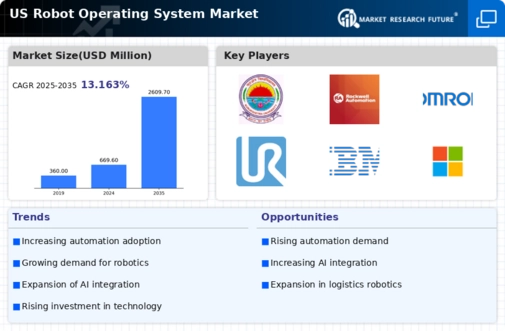The competitive landscape of the US Robot Operating System Market is characterized by a dynamic interplay of technological advancements and innovation-driven strategies among key players. As automation continues to gain momentum across various sectors, companies are leveraging sophisticated robot operating systems to enhance efficiency, flexibility, and interoperability in their robotic solutions. Firms in this market are focusing on integrating artificial intelligence, machine learning, and real-time data analytics into their operating systems to cater to diverse applications ranging from manufacturing to healthcare.
The competitive insights indicate a strong emphasis on user-friendly interfaces, robust support systems, and seamless integration capabilities which are critical in sustaining competitive advantages in a rapidly evolving market.
Companies are also exploring partnerships, alliances, and acquisitions as strategies to bolster their market presence and technological edge.KUKA holds a prominent position in the US Robot Operating System Market, recognized for its cutting-edge automation solutions. The company's strengths lie in its extensive product portfolio, which includes a range of industrial robots and collaborative robots designed to enhance productivity across various industries. KUKA is notable for its innovative approach to robotics, offering advanced operating systems that facilitate superior programming and operational efficiency.
The company's significant investment in research and development has enabled it to maintain a competitive edge, particularly with its emphasis on modular architectures and flexible automation solutions tailored to meet the specific needs of the US market. KUKA's commitment to providing robust support and training services further reinforces its market presence, allowing clients to optimize their robotic operations effectively.ABB enjoys a substantial foothold in the US Robot Operating System Market, known for its comprehensive suite of products and services that cater to robotics and automation needs.
The company offers a wide array of robotic systems and solutions, including industrial robots, collaborative robots, and control systems that enhance productivity and safety in manufacturing environments. ABB's strengths lie in its unwavering focus on innovation and user-centric design, enabling seamless integration of its operating systems with existing manufacturing processes. The company's recent mergers and acquisitions have strategically expanded its market reach and technological capabilities within the US. Key products such as the ABB Ability platform illustrate the company's dedication to offering digital solutions that optimize operations and improve efficiency in various applications.
Through its robust market strategy and commitment to customer satisfaction, ABB continues to solidify its leadership position in the US Robot Operating System Market, ensuring that it meets the evolving demands of industries seeking advanced automation solutions.























Leave a Comment